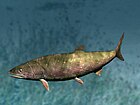Halecomorphi: Difference between revisions
No edit summary |
No edit summary |
||
| Line 27: | Line 27: | ||
}} |
}} |
||
'''Halecomorphi''' is a [[taxon]] of [[Actinopterygii|ray-finned]] [[bony fish]] in the [[clade]] [[Neopterygii]]. The |
'''Halecomorphi''' is a [[taxon]] of [[Actinopterygii|ray-finned]] [[bony fish]] in the [[clade]] [[Neopterygii]]. The only extant Halecomorph species are the [[bowfin]] (''Amia calva'') and eyespot bowfin (''[[Amia ocellicauda]]''), but the group contains many extinct [[species]] in several [[family (biology)|families]] (including [[Amiidae]], [[Caturidae]], [[Liodesmidae]], [[Sinamiidae]]) in the [[order (biology)|order]] [[Amiiformes]], as well as the [[extinct]] orders [[Ionoscopiformes]], [[Panxianichthyiformes]], and [[Parasemionotiformes]]. The fossil record of halecomorphs goes back at least to the [[Early Triassic]] [[epoch (geology)|epoch]]. |
||
[[File:Watsonulus eugnathoides.png|thumb|left|The parasemionotiform †''[[Watsonulus]]'']] |
[[File:Watsonulus eugnathoides.png|thumb|left|The parasemionotiform †''[[Watsonulus]]'']] |
||
Revision as of 21:13, 7 February 2023
| Halecomorphi Temporal range:
| |
|---|---|

| |
| Cretaceous †Cipactlichthys scutatus | |

| |
| Amia calva (bowfin) | |
| Scientific classification | |
| Domain: | Eukaryota |
| Kingdom: | Animalia |
| Phylum: | Chordata |
| Class: | Actinopterygii |
| Subclass: | Neopterygii |
| Infraclass: | Holostei |
| Clade: | Halecomorphi Cope, 1872 |
| Orders and families[1] | |
Halecomorphi is a taxon of ray-finned bony fish in the clade Neopterygii. The only extant Halecomorph species are the bowfin (Amia calva) and eyespot bowfin (Amia ocellicauda), but the group contains many extinct species in several families (including Amiidae, Caturidae, Liodesmidae, Sinamiidae) in the order Amiiformes, as well as the extinct orders Ionoscopiformes, Panxianichthyiformes, and Parasemionotiformes. The fossil record of halecomorphs goes back at least to the Early Triassic epoch.






The Halecomorphi exhibit a combination of ancestral features, such as most heavily mineralized scales, but also by more derived or "modern" features, particularly in the structure of the skull (e.g. position and shape of preopercles). Unique derived traits (synapomorphies) of the Halecomorphi include:[2]
- Unique jaw articulation in which the quadrate and symplectic participate in the joint.
- Lengthened dorsal fins (in some species)
- Two biconcave vertebrae per segment in the posterior body region (a condition known as diplospondyly)
- Fan like arrangement of small bones (hypurals) in the tail.
Systematics and phylogeny
On the systematic position of the Halecomorphi, there are two competing hypotheses:
- The Halecostomi hypothesis proposes Halecomorphi as the sister group of Teleostei, the major group of living neopterygians, rendering the Holostei paraphyletic.[3]
- The Holostei hypothesis proposes Halecomorphi as the sister group of Ginglymodi, the group which includes gars (Lepisosteidae) and their fossil relatives, rendering the Halecostomi paraphyletic.[4][5][6]
The latter hypothesis is more widely accepted.[7][8][9][10]
| Neopterygii |
| ||||||||||||
The following cladogram[11] summarizes the evolutionary relationships of extinct (indicated with a dagger, †) and living orders of Halecomorphi.
| Halecomorphi |
| ||||||||||||||||||
References
- ^ J. S. Nelson; T. C. Grande; M. V. H. Wilson (2016). Fishes of the World (5th ed.). Wiley. p. 752. ISBN 978-1-118-34233-6.
- ^ Ax, Peter [translated by Dr.Richard. E. Dunmur] (2010). "Halecomorphi — Teleostei". Multicellular Animals. Berlin: Gardners Books. pp. 207–210. doi:10.1007/978-3-662-08874-6_29. ISBN 978-3-642-05515-7.
- ^ Patterson C. Interrelationships of holosteans. In: Greenwood P H, Miles R S, Patterson C, eds. Interrelationships of Fishes. Zool J Linn Soc, 1973, 53(Suppl): 233–305
- ^ Olsen P. E. (1984). "The skull and pectoral girdle of the parasemionotid fish Watsonulus eugnathoides from the Early Triassic Sakemena Group of Madagascar with comments on the relationships of the holostean fishes". J Vertebr Paleontol. 4: 481–499.
- ^ Grande, Lance; Bemis, William E. (1998). "A Comprehensive Phylogenetic Study of Amiid Fishes (Amiidae) Based on Comparative Skeletal Anatomy. an Empirical Search for Interconnected Patterns of Natural History". Journal of Vertebrate Paleontology. 18 (sup001): 1–696. doi:10.1080/02724634.1998.10011114.
- ^ López-Arbarello, Adriana; Sferco, Emilia (March 2018). "Neopterygian phylogeny: the merger assay". Royal Society Open Science. 5: 172337. doi:10.1098/rsos.172337.
- ^ Betancur-R (2016). "Phylogenetic Classification of Bony Fishes Version 4".
- ^ Nelson, Joseph, S. (2016). Fishes of the World. John Wiley & Sons, Inc. ISBN 978-1-118-34233-6.
{{cite book}}: CS1 maint: multiple names: authors list (link) - ^ "Actinopterygii". Integrated Taxonomic Information System. Retrieved 3 April 2006.
- ^ R. Froese and D. Pauly, ed. (February 2006). "FishBase".
- ^ Sun, Zuoyu; Tintori, Andrea; Xu, Yaozhong; Lombardo, Cristina; Ni, Peigang; Jiang, Dayoung (April 2017). "A new non-parasemionotiform order of the Halecomorphi (Neopterygii, Actinopterygii) from the Middle Triassic of Tethys". Journal of Systematic Palaeontology. 15 (3): 223–240. doi:10.1080/14772019.2016.1181679.
- Brian J. Gardiner, John G. Maisey, D. Tim J. Littlewood: Interrelationships of Basal Neopterygians. S. 117-146 in: Melanie L. J. Stiassny, Lynne R. Parenti, G. David Johnson (Hrsg.): Interrelationships of Fishes. Academic Press, 1996, ISBN 0-12-670950-5






